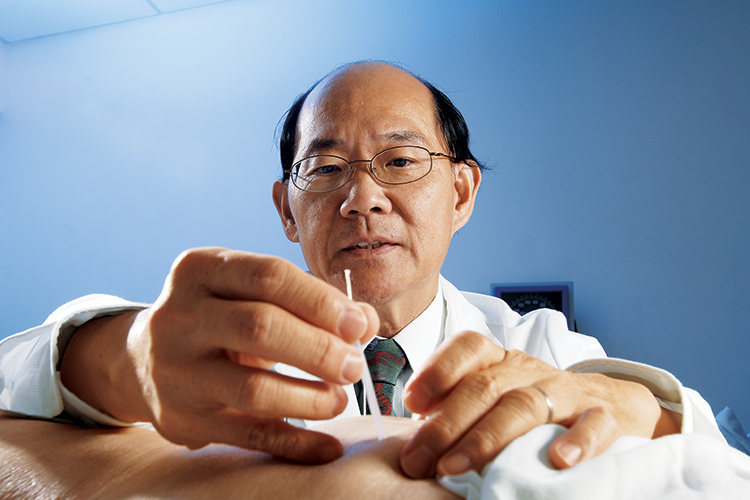Acupuncture for Myositis: What You Should Know
Adapted from a presentation to the Myositis Support Group
Introduction
Dr. Ngeow began his presentation with some facts about the increased interest in the use of acupuncture, noting that there has been a growing trend toward a more holistic approach to healthcare.
Dr. Ngeow cited a 1997 consensus statement in which an NIH (National Institutes of Health) panel of experts confirmed the effectiveness of acupuncture in such diverse conditions as headaches, asthma, post-operative or post-chemotherapy nausea and vomiting, and drug addiction. Other treatable conditions included dental and post-operative pain, carpal tunnel syndrome, tennis elbow, fibromyalgia, and back pain.
While it is possible for serious complications to occur, there have been relatively few reports of complications arising from acupuncture.
Dr. Ngeow stressed the importance of seeking an experienced, licensed acupuncturist. He offered that physicians and dentists require 300 hours of training, while non-physicians must complete 3,000 hours of training in order to receive a license to practice acupuncture in New York State.

HSS anesthesiologist Jeffrey Y. F. Ngeow, MD, treats a patient using acupuncture.
A Brief History of Acupuncture
- Though acupuncture dates back to primitive times, the more "modern" form of acupuncture, based on traditional Chinese medicine (TCM), dates back to about 2,500 years.
- TCM is the result of traditional beliefs and contemporary philosophies that consider our internal being as reflection of our external environment, and that a state of harmony (balance) must be maintained in order to prevent disease.
- It has its origins in helping to relieve pain; treatment was based on focusing treatment at the physical site of the pain.
- TCM theories for control of our inner environment include the concepts of qi (air/energy, sometimes spelled “chi,” “ch’i” or “ki”) and xie (blood/nutrition, sometimes spelled "xue"), yin and yang (dynamic flux) and the five movements (equilibrium), while maintaining the balance of these.
Simple Explanations of These Concepts
- Qi means the breath, energy that is produced by all internal organs. Qi must flow smoothly throughout the body in orderly, circular patterns along defined pathways called meridians. If there is too much qi, such as with obstruction, then painful conditions occur.
- Xie means blood, nutrition or life force. It controls growth and determines the function of every organ.
- Qi and xie are dependent on each other.
- A very simple example was offered to understand this concept:
“Qi is the switch that carries the impulse to generate xie, the electricity.” - The forces of yin and yang:
- Yin represents the female, the internal. It is cool and subdued.
- Yang represents the male, the external. It is warm and excited.
- These are two opposing forces and are always changing.
- A balance of the two creates harmony internally and externally.
- When not in balance, disease occurs.
- The five elements (movements) relate to the internal organs. The elements involved are: fire, earth, metal, water, and wood. Our system expresses the quality of each of these elements. They are in constant motion, like the seasons.
How These Theories of TCM Are Used in the Practice of Acupuncture
- Most acupuncture points lie along defined meridians, or channels.
- Using thin needles that are turned by hand or stimulated by electricity, acupuncture re-establishes qi (energy) flow along the meridian that will affect that organ or system the most where qi is obstructed.
- Very specific manipulations of the needles are also used to enhance the yin or yang.
Chronobiology in TCM
- This is the concept that each organ has its maximum function at different two-hour periods in a day.
- According to TCM, then, treatment is most effective when given at a time that matches the peak functioning of the system being treated.
- Likewise, the disease state of a system is likely to occur during its weakest period.
Controlling Pain Through Acupuncture
- Recent studies have shown that acupuncture is able to produce significant changes and increases in the level of endorphins (which help to control pain).
- By stimulating certain nerves, the spinal cord and brain are activated to release these endorphins.
- Acupuncture also affects certain rapid expressed genes that control cellular hormones (cytokines) which modulate pain perception.
Acupuncture and Myositis
- It is unknown if acupuncture is an effective treatment for myositis. As stated above, however, it can be an effective treatment, in combination with other treatments that are being prescribed for you, for pain associated with myositis.
- It is important to remember to continue to take your medications, as prescribed by your doctor, if you choose to undergo acupuncture treatments.
In Considering the Use of Acupuncture
- You may want to consider trying acupuncture to get more pain relief or if you want to avoid the side effects of strong pain medicine or non-steroidal anti-inflammatory drugs (NSAIDs).
- First, discuss this with your physician and ask for a recommendation from him or her.
- It is important to locate an experienced and licensed acupuncturist with a proven track record.
- While rare, with very few reports of serious side effects, they can occur and should be discussed with your acupuncturist prior to treatment.
About the Myositis Support Group at HSS
Learn more about the Myositis Support Group, a free support and education group held monthly at Hospital for Special Surgery.
Authors
Anesthesiology, Hospital for Special Surgery
Related articles
Summary by Suzan Fischbein, LCSW, Myositis Support Group Coordinator
